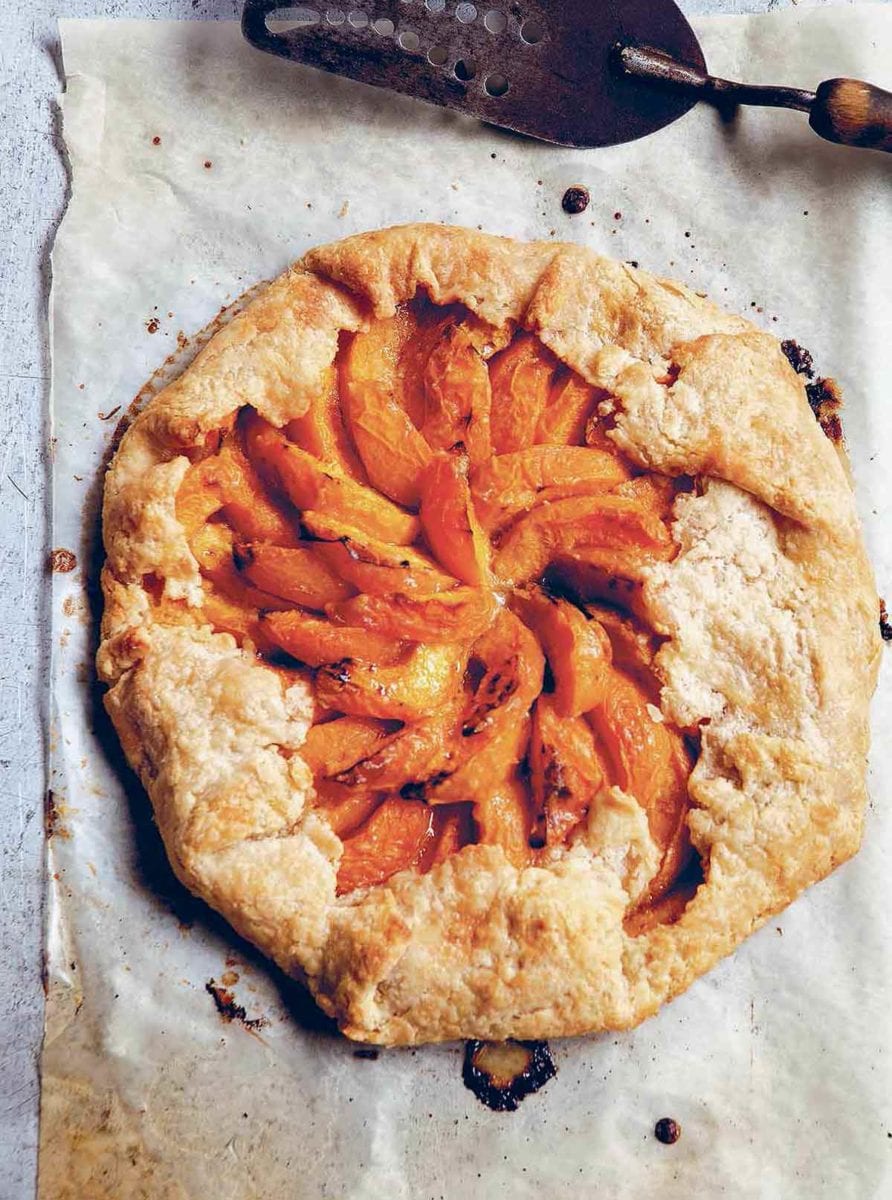

Apricot galette. It sounds fancy although it’s actually quite simple to toss together with a pleasingly rustic look. Yet it’s still impressive as heck. Here’s how to make it.

A galette is one of those dishes that is more of a formula than a recipe. Once you learn the basics, you can make a galette with other stone fruits such as peaches, nectarines, plums, or even apples or pears, flavored with a dash of cinnamon. In the desperate months of winter, we’ve even made this galette with frozen fruit and eaten it as a picnic on the living room floor. It’s great for breakfast the next morning.–Faith Durand
HOW IS A GALETTE DIFFERENT FROM A PIE?
Does pastry that won’t rip or tear or sag or crumble elude you? Are you all thumbs when it comes to the perfect crimp? A galette is a perfect solution–a bottom crust with a pleated, folded edge and no top crust. From the French, a galette is a simpler, more freeform dessert solution. And because there’s isn’t a top crust, you’re left with pastry that doesn’t demand perfection, one where an uneven edge or a burnished bump is simply charming. It’s the perfect pie alternative seeing as the galette, by definition, is charmingly imperfect.
Apricot Galette

With an apricot galette, you have the best of summer—a ripe, sweet fruit that speaks for itself, needing very little added sugar and a light, buttery crust that’s fuss-free.
Make the crust
-
Combine the flour, sugar, and salt in a food processor and pulse a few times to combine. Scatter the butter pieces over the mixture and pulse until the pieces of butter are about the size of peas. (Alternatively, whisk the flour and sugar together in a large bowl and work the butter in with a pastry blender or 2 knives.)
-
Sprinkle the ice water over the mixture, 1 tablespoon at a time, and pulse once (or gently toss the mixture with a fork) after each addition. Continue adding water and pulsing (or stirring) until the dough forms small crumbly lumps, like cottage cheese, that clump when you pinch them together. Chances are you won’t need all 6 tablespoons of ice water. Be careful not to overprocess the dough. It should not form into a ball while still in the food processor. [Editor’s Note: These cautions make the pastry sound really fussy, but we swear, it’s not. It’s actually easy as can be. And just wait, because the finished crust is so buttery and tender and crunchy you’re going to be hooked.]
-
Dump the dough out onto a lightly floured work surface and pat it into a 1-inch-thick disk, being careful not to handle it too much. Don’t knead the dough. Simply wrap it in plastic wrap and refrigerate for at least 30 minutes. (Or wrap it well in plastic wrap and freeze it for up to 3 months. To use, thaw it in the refrigerator overnight.)
Make the apricot filling
-
In a large bowl, combine all but 1 teaspoon granulated sugar, the brown sugar, flour, salt, and nutmeg. Add the apricots and toss until evenly coated. Take a nibble and if your eyes scrunch up and your face puckers, add a touch or a ton more granulated sugar, depending on just how puckery the apricots are. Some apricots are just tarter than others.
To assemble and bake the galette
-
Position a rack in the lower third of the oven and preheat the oven to 400°F (204°C). Line a baking sheet with parchment paper and set it aside.
-
On a lightly floured work surface, roll out the chilled dough to a 14-inch-diameter circle. (If you have trouble rolling the chilled dough, let it rest at room temperature for about 10 minutes, and then try again.) Move the dough to the prepared baking sheet.
-
Arrange the apricot filling in the center of the crust, leaving a 2-inch border of dough around the edges. Fold the edges over the filling, pinching pleats in the crust as you proceed. Dot the exposed fruit with the cubed butter. Brush the edges of the crust with the cream, and then sprinkle with the remaining 1 teaspoon sugar.
-
Bake the galette for 40 minutes, and then lower the oven temperature to 350°F (177°C) and bake for another 10 to 20 minutes, or until the crust is golden brown and the edges are slightly caramelized.
-
Remove the baking sheet from the oven and set it on a wire rack for a few minutes to cool slightly. Slip the parchment paper with the galette off the baking sheet and onto the wire rack, and allow the galette to cool. Serve warm or at room temperature with a dollop of whipped cream or crème fraîche or a scoop of ice cream. The galette can be covered with plastic wrap and refrigerated for up to 2 days.
Serving: 1portionCalories: 246kcal (12%)Carbohydrates: 29g (10%)Protein: 3g (6%)Fat: 14g (22%)Saturated Fat: 8g (50%)Polyunsaturated Fat: 1gMonounsaturated Fat: 4gTrans Fat: 1gCholesterol: 35mg (12%)Sodium: 149mg (6%)Potassium: 205mg (6%)Fiber: 2g (8%)Sugar: 12g (13%)Vitamin A: 1718IU (34%)Vitamin C: 7mg (8%)Calcium: 18mg (2%)Iron: 1mg (6%)
Originally published July 20, 2015
![]() If you make this recipe, snap a photo and hashtag it #LeitesCulinaria. We’d love to see your creations on Instagram, Facebook, and Twitter.
If you make this recipe, snap a photo and hashtag it #LeitesCulinaria. We’d love to see your creations on Instagram, Facebook, and Twitter.


